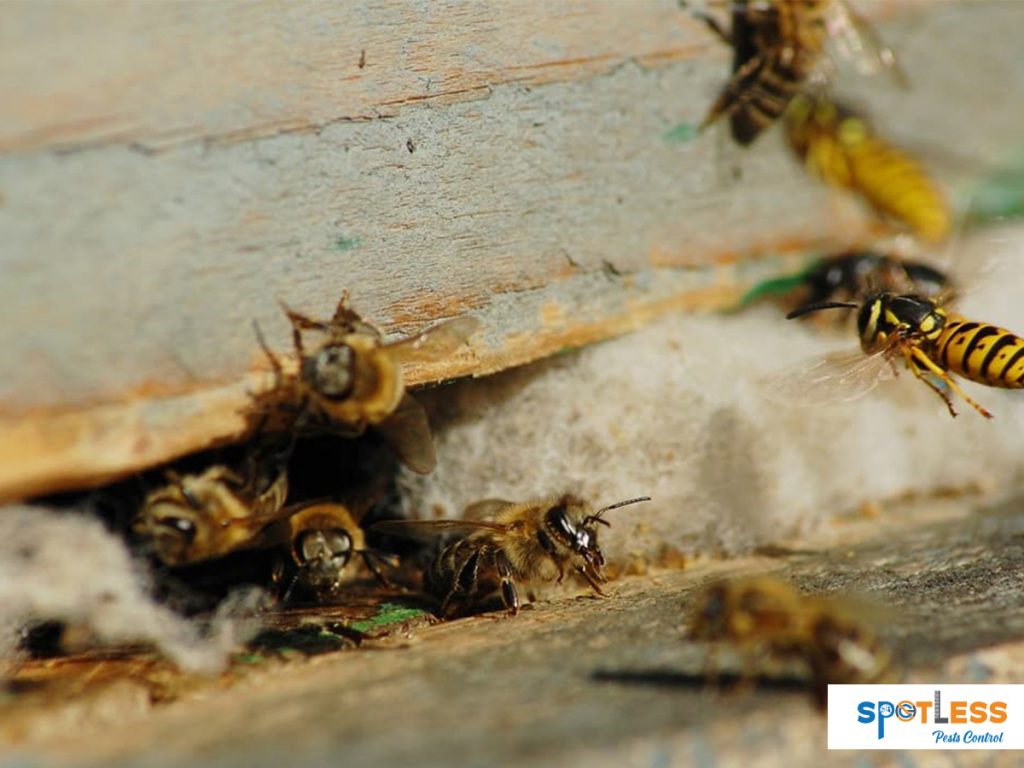Addressing Bees And Wasp Control The Right Way!
Did you know Bees and wasps play integral roles in maintaining a proper of the balance of the ecosystem? While bees are known for their fundamental role in pollination, wasps serve a great way of effectively controlling pest populations. Apart from these benefits, these insects can sometimes infest residential or commercial structures in search of suitable nesting sites and it ends up causing a nuisance. So let’s begin today’s discussion about how bees and wasps actively help in our ecosystem, signs of infestation and how to tackle them efficiently.
How Bees And Wasps Contribute Towards A Balanced Ecosystem?
As we have stated above, bees and wasps contribute towards a balanced ecosystem but how do those tiny creatures have so much to contribute? Let’s understand how.
Pollination is a process of transferring the pollen of plant from the male parts to the female parts of a flower which eventually leads to the reproduction of most plants. Bees and wasps serve as primary pollinators (the one who carries pollen from one plant to another) for a wide range of plants, including fruits, vegetables, and nuts. It can be said that in the absence of bees, many of these plants would not be able to produce seeds or fruit, which could lead to a devastating impact on the food chain and ecosystem. Not only these bees help in enhancing the crop yield and quality due to cross-pollination. Apart from this bees also produce honey, that’s delicious and contains many health benefits.
The next benefit that we derive from bees and wasps is that they naturally help to control pest populations. Many species of wasps act like natural predators of insects this helps in keeping their populations in check. Apart from these, they act as a food source for other kinds of animals, birds and small mammals.
How Do Infestations Of Bees And Wasps Typically Occur?
While bees and wasps have many advantages their infestation does cause a nuisance for humans. Here we have listed the way by which bees and wasps ideally choose a spot for building a cozy shelter for themselves. Staying aware of it will help you to avoid welcoming infestations in future by taking the right steps to keep them away.

1.Scouting
In the very first step, they search for locations that provide shelter, protection, and good proximity to food sources. They look for ideal nesting sites that are often hidden from predators, have a stable temperature, and offer easy access to building materials and resources.
2.Nesting Sites
Next begins the construction of their nests. Bees often build hives in hollow trees, wall cavities, or roof spaces. While in the case of Wasps, they build nests in similar locations or attach them to the underside of eaves, decks, or other overhangs.
Bees build their hives using wax, which they produce from glands in their abdomen. The hive primarily consists of hexagonal cells where they store honey and pollen and raise their young ones. While on the other hand Wasps, construct nests using a papery material made from chewed wood fibres mixed with their saliva. The nest contains multiple cells for raising larvae.
Effective Bees Control At Cheap Rates To Keep The Painful stings away!
3.Colony Expansion
While the colony grows, more bees or wasps are attracted to the nest. With time the nest can become quite large, housing hundreds or even thousands of insects. During this period it is observed insects become more aggressive, particularly when they notice a threat to their nest.
4.Swarm Or Relocation
Mostly bees swarm a natural process in which a large group of bees leaves the hive with a new queen to establish a new colony elsewhere. This primarily occurs when the original colony becomes overcrowded.
While wasps do not swarm like bees, their colonies die out at the end of the season, with only the fertilized queens surviving to establish new colonies the following year.
Tackling Bees And Wasps Infestation
By now you understand how important is the role of bees and wasps in pollinating plants and controlling insect populations, but they can become a nuisance and even pose a threat to humans when they infest residential and commercial areas. To ease your issues here are some ways to keep bees and wasps away from these places:
- Seal any kinds of cracks or gaps in walls, doors, windows, and roofs to prevent bees and wasps from entering buildings.
- If you spot a nest, do not try to remove it yourself it can be extremely dangerous. Instead, Call a pest control professional like Spotless Pest Control to remove the nest safely.
- Bees and wasps are drawn to food and sweet smells, so keep food covered and clean up spills promptly. Use sealed trash cans and compost bins to stop welcoming them to your house.
- Planting herbs and flowers like mint, basil, and marigolds act as natural repellents for bees and wasps. Essential oils for instance like peppermint and eucalyptus can also be utilized to deter them effectively. As they hate such kind of strong scents.
- They are attracted to bright colours, especially yellow and blue. So try and avoid wearing bright clothing or using brightly coloured outdoor furniture.
- Trim bushes and trees regularly, and remove any fallen fruit or debris from the ground. Keeping your ground clean and tidy will keep them away.
By taking these steps, you can help keep bees and wasps away from residential and commercial areas while also preserving their important role in the ecosystem. If you discover an infestation, consider contacting a professional pest control service, as removing nests can be dangerous, especially for those allergic to stings.
For any further queries regarding bees and wasp infestation get in touch with Spotless Pests Control to address the issue at the earliest.




